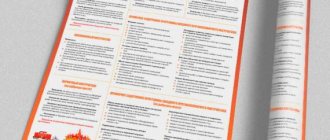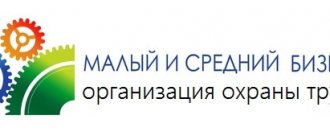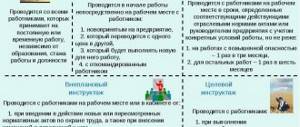The fire safety condition of the territory, workshops, various structures of industrial enterprises, administrative and public buildings is ensured by many factors. First of all, fire safety at facilities depends on the general level of organization of the entire range of measures aimed at solving this serious problem.
Regulatory documents on fire safety at facilities include:
- Federal Law No. 69-FZ and 123-FZ;
- Fire regulations in the Russian Federation (RPR);
- official codes of practice (SP) related to food security.
Based on their requirements, each enterprise, organization or institution must develop and have available, including for presentation to representatives of state supervisory authorities, a complete package of fire safety documentation.
It includes both basic documents, identical in form for organizations of any form of ownership, and various additional orders, instructions, acts necessary for objects of different functional purpose and fire hazard; since they cannot be completely identical for a high school, a shopping center or a hydrocarbon processing plant. Let's take a closer look at the list and the list of main documents.
What documents need to be completed?
Every enterprise or organization must have a correctly compiled set of documents on fire safety issues.
Of course, the presence of such documents protects against fire and its consequences very indirectly. But this is useful from the point of view of protection from criminal or administrative liability. Which is especially important in view of the recent activity of the Ministry of Emergency Situations regarding checklists. Here is an approximate list of local fire safety regulations. But each enterprise has its own specifics, depending on the industry, type of activity, size, work performed, etc. There are specific features that depend on the structure of the organization. For example, for small companies (where there is only one facility, and the owner is personally responsible for everything), one general fire safety order is drawn up. For legal entities with several structural divisions, the person responsible for fire safety is appointed by order for each structural division, as well as for the enterprise as a whole. In this case, the object of protection will be each unit: workshop, site, construction site, etc.
When carrying out hot work for both large enterprises and small companies (even if the hot work is carried out by the owner himself), it is necessary to draw up a work permit for such work.
Logging Rules
The fire safety briefing log contains:
- date;
- Full name of the person being instructed;
- the year of his birth;
- profession, position;
- type of instruction;
- Full name of the person instructing;
- signatures of the person being instructed and the person instructing.
The document must be stitched, laced and numbered before use. It is also necessary to seal the magazine by gluing a paper strip to the ends of the lacing indicating the number of numbered and laced sheets. The stamp should fall partly on the seal and partly on the last page. The accounting document is certified by the signature of the manager.
You can purchase a ready-made magazine from a printing house or print and stitch it yourself using the sample below.
Orders
The head of the enterprise must issue the following orders (approximate list):
- Order on the appointment of those responsible for fire safety.
- Order on the appointment of those responsible for the provision and good condition of primary fire extinguishing equipment.
- Order on the appointment of those responsible for fire safety during explosion and fire hazardous work.
- Order on the appointment of those responsible for the procedure for conducting fire safety briefings.
- Order on the procedure for conducting fire safety training.
- An order on the procedure for de-energizing electrical equipment in the event of a fire and at the end of the working day, on the procedure for inspecting and closing premises.
- Order on the procedure for cleaning up flammable waste and dust.
- Order on identifying and equipping smoking areas.
- Order on conducting fire safety training with personnel.
Fire extinguisher inspection log
Organizations also check fire extinguisher inspection logs; this is a requirement of fire safety regulations. What is the document:
- The first column indicates the number in order.
- The next column indicates the brand of the fire extinguisher.
- In the third is the serial number of the primary fire extinguishing agent.
- The next column indicates when the inspection was carried out, and then the date of the next verification.
- The location of the fire extinguisher is also indicated.
Why are these logs filled out?
- It is necessary to know the location of fire extinguishers in order to navigate where they are. This will make it easier for firefighters to carry out inspections.
- Fire extinguishers are valuable assets and it is important that they do not go to waste.
- Ensuring control over timely verification of fire extinguishing equipment.
Fire Safety Instructions
Each organization must develop the following fire safety instructions (approximate list):
- General facility instructions on fire safety for the entire enterprise.
- Fire safety instructions for those responsible for routine inspection of fire extinguishers.
- Instructions for use of internal fire-fighting water supply.
- Fire safety instructions for each protected object.
- Instructions on the actions of personnel to evacuate people in case of fire.
- Instructions on the actions of personnel for evacuation at facilities with overnight stays of people (psycho-neurological dispensaries, orphanages, nursing homes, boarding schools for the disabled, shelters, children's reception centers, healthcare institutions, etc.)
- Instructions on the procedure for the duty personnel to act upon receiving a signal about a fire or malfunction of the alarm system or fire extinguishing system, internal fire water supply.
Fire safety in organizations
Fire equipment / Articles / Fire safety in organizations
Fire safety in an organization is a set of measures taken in two directions:
- prevention of fire hazards;
- compliance with rules of behavior in case of fire.
The main guarantor of fire safety in an organization is its leader, who:
- is responsible for the list, development and approval of local documents regulating security;
- appoints responsible persons;
- monitors the timely conduct of briefing and training of all personnel;
- is responsible for having a fire evacuation plan and monitoring the behavior of personnel in a fire-hazardous situation.
Fire safety officials
Quite often, the manager is responsible for fire safety at an enterprise. This is especially true for small organizations. If we are talking about a large company, by order of the manager, persons responsible for fire safety are appointed.
Need advice on fire safety?
Send an application
The person responsible for fire safety must have a higher technical education and management experience. Before taking up duties, this employee undergoes mandatory training according to the fire-technical minimum program, which is evidenced by a special certificate. In the future, the person responsible for fire safety will have to conduct regular training of personnel, draw up documentation, and communicate with representatives of regulatory authorities during scheduled inspections.
Fire safety magazines
An employee responsible for fire safety in an organization, in accordance with his authority, is required to keep fire safety logs. There are several types of logs, depending on what data needs to be recorded.
Full list of fire safety magazines:
- log of fire safety briefings;
- a log of checking the fire safety condition of premises before closing them at the end of work;
- logbook for monitoring the condition of primary fire extinguishing equipment;
- fire extinguisher maintenance log;
- fire extinguisher testing and recharging log;
- fire hydrant log book;
- technical inspection log of fire hydrants;
- inspection log of fire hydrants, intake devices in reservoirs, fire pumps and panels;
- logbook for maintenance and repair of fire extinguishing installations;
- log of failures of automatic fire protection systems;
- logbook for recording maintenance and preventive maintenance of fire automatic systems.
Each magazine must be sewn and sealed. All of them are under the responsibility of the responsible person. Proper filling out fire safety logs helps resolve and even prevent many controversial or conflict situations with representatives of regulatory authorities.
Fire safety briefing
The responsibilities of the person responsible for fire safety include developing a program for instructing all employees of the organization, regardless of their specialty and work experience.
Depending on the nature of the content, fire safety training can be of the following types:
- introductory;
- primary at the workplace;
- repeated;
- unscheduled;
- target.
Upon completion of the instruction, an entry is made in the fire safety journal, which is certified by the signatures of the instructor and the person being instructed.
Actions in case of fire
The first thing every employee needs to do when they discover a fire or any signs of burning is to report it to the fire department.
Persons responsible for fire safety must:
- notify fire services, management and security;
- immediately organize the evacuation of personnel and material assets;
- turn off the power supply and block the operation of ventilation systems, take measures to prevent the spread of fire and combustion products;
- make sure that the activation of automatic fire protection systems has worked;
- take measures to extinguish the fire before the arrival of the fire department;
- monitor compliance with safety regulations by persons involved in firefighting;
- meet the fire department, provide it with unhindered and speedy access to the facility;
- inform firefighters about the technological and design features of the facility, the presence of specific flammable substances at the facility and other potentially dangerous factors.
The safety of life and health of employees, the safety of property and material assets is one of the primary tasks of the head of any organization. Strict adherence to fire safety rules, timely instruction of personnel, taking preventive measures that take into account the specifics of the enterprise - all this can protect against fire. And it is reasonable to entrust the work of preventing fire hazards to professional experts.
| " Back |
Conducting briefings
Training and instruction is a critical element of fire safety. At each enterprise, all employees must undergo fire safety training: introductory training - upon hiring, initial training at the workplace before starting independent work, and then periodically at least once every six months (once a quarter when carrying out explosive and flammable work). Conducting briefings is very similar to instructing in the occupational safety and health system. To register instructions, the organization must keep fire safety logs, and the following documents must be present:
- Fire safety training log.
- Introductory and periodic fire safety training programs.
About briefings
What types of fire safety training exist:
- Introductory. Conducted by a specialist authorized to conduct it before a new employee enters the facility for the first time. The latter must know all possible dangers and how to deal with them in the event of a fire. To instruct employees, instructions are approved; visual aids can also be used, a film can be watched, etc.
- Primary. And so, the employee approached the workplace. He now needs to be aware of the possible hazards he will face in the workplace. This type of instruction is carried out by the immediate supervisor. For this type of instruction, a special program is developed, according to which a summary is prepared.
- Repeated. At this type of briefing, the manager tells everything as in the primary briefing. The essence of the event is to remind you of your own safety while working. Any employee is busy producing and executing the plan and can forget about his own safety. During the training process, the employee is reminded what to do in a particular case. A training program should also be developed.
- Unscheduled. This type of instruction applies to the following situations: if new equipment and, accordingly, technological processes have been introduced; when new instructions on industrial safety are introduced; in the event of a fire; if an accident occurs. This type of instruction is provided as a reminder or when introducing new rules.
- Target. This type of instruction involves performing one-time work, for example, painting with oil paint or lighting a bitumen boiler. The employee must be instructed before performing this type of work.
All types of briefings are regulated by regulatory documents.
PTM training
Employees of the enterprise undergo fire safety training in accordance with the order of the Ministry of Emergency Situations No. 645 of December 12, 2007. The order lists categories of employees who undergo PTM training only at the training center, as well as categories of employees who can undergo training at the enterprise itself. To confirm personnel training, the following documents must be prepared:
- Personnel training programs for PTM.
- List of questions to test employees' knowledge.
- Training plans (schedules).
- Protocols for testing knowledge of fire safety requirements to the extent of the fire-technical minimum.
- Certificates of completion of PTM training.
- Plans and schedules for fire drills.
- Certificate (report) on fire training.
- Fire training logbook.
Additionally
Depending on the type of activity at the enterprise, the following documents may be required:
- Fire safety instructions for each fire-hazardous, explosive and fire-hazardous industrial and warehouse premises. This requirement is established in accordance with paragraphs. 2 Fire regulations in the Russian Federation (RF Government Decree No. 390).e
- Fire risk calculation. Fire risk calculations are carried out only by independent accredited organizations in accordance with Article 144 of Federal Law No. 123.
- The fire safety declaration is developed in accordance with Art. 6 and 64 Federal Law of July 22, 2008 No. 123-FZ. The requirements for the composition of the declaration are listed in Order of the Ministry of Emergency Situations of Russia dated February 24, 2009 No. 91 “On approval of the form and procedure for registering a fire safety declaration.”
- Production instructions for personnel servicing equipment at hazardous production facilities.
- Regulations on the creation of a gas rescue service (at hazardous production facilities).
- Regulations on the creation of emergency rescue teams (at hazardous production facilities).
- Work plans and technological maps for fire and explosion hazardous work.
- Certificates for materials and substances used in production.
- Work permits for performing explosion and fire hazardous work.
See the article Ensuring fire safety of the facility
View New fire safety checklists
Penalty for missing a journal
Responsibility for violation of fire safety standards is provided for in Art. 20.4 Code of Administrative Offenses of the Russian Federation. The lack of a log of fire safety briefings will be perceived by supervisory authorities as a violation of established fire safety requirements, and if the first time inspectors can limit themselves to a warning, then a repeated violation will definitely entail a fine:
- for legal entities - from 150,000 to 200,000 rubles;
- for officials - from 6,000 to 15,000 rubles.
Under special fire conditions, the fine is higher:
- for legal entities - from 400,000 to 500,000 rubles;
- for officials - from 15,000 to 30,000 rubles.









